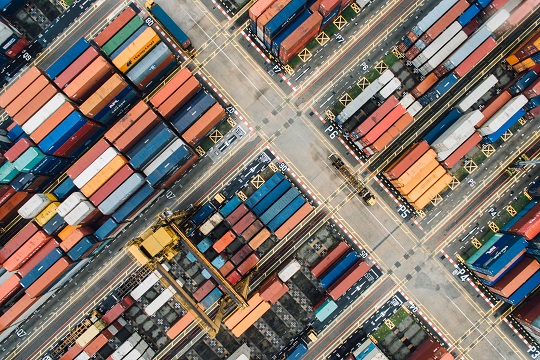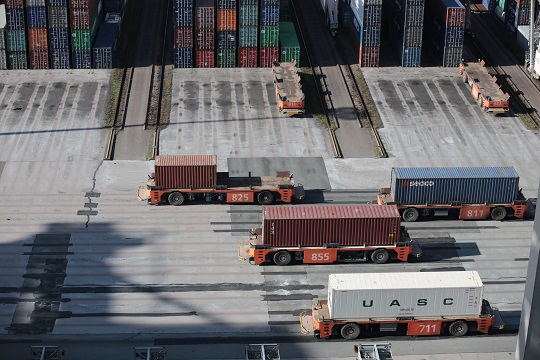One time, a company asked me to help them set up a container yard. Based on what they learned from their research, they decided to run a container yard instead of a warehouse.
No matter what the company thinks, I’ll tell you what you should think about when it comes to running a container yard. Who knows if you don’t plan to do the same thing?
But before we go any further, make sure you have also joined the scmguide telegram channel to learn more about supply chain management and to make sure you don’t miss the latest blog post updates.
Table of Contents
When running a container yard, there are 8 things to think about
Now, let’s look at a few things you should think about before you decide to run a container yard to help your manufacturing business.
How strong is a container yard floor?
The first thing you need to think about is, of course, how to build the container yard.
You have to remember that the reach stacker will stack the containers that you will store there.
When stacking the containers, you have to think about both how much the stack weighs and how much the reach stacker is moving.
Of course, you don’t want the floor you’ve prepared to get damaged quickly, because that would make working in the container yard less safe.
So, make sure the floor of your container yard is strong enough to hold the weight of the stack of containers and the reach stacker that will work there.
You might also like:
Container yard layout is the next thing you should think about
You must make sure that the space between the stacks of containers is wide enough for your reach stacker to move around. Compared to the aisle in the warehouse, it is obviously much wider.
Set up your container stack so that you don’t waste a lot of empty space.
Don’t forget to think about how many trucks will be entering and leaving your container yard.

Don’t let too many intersections happen in your container yard, because that will make it less safe.
And it’s just as important to mark your layout clearly so that all the stacks of containers and the flow of trucks stay the same as you planned.
Also, put up signs that are easy to see to warn people who work in your facility.
Reach stacker: rent or buy?
To run a container yard, you will need a reach stacker to put containers on top of each other or pick them up.
If you have enough money, you can buy it. If not, you can rent it. Just make sure that the specifications fit your needs, such as the weight per container or the height of the stack of containers.
Depending on how strong your container yard floor is, you can stack up to 4 or 6 stacks.
You should know that whether you buy or rent this reach stacker, the price will be much higher than the price of a forklift. The operator’s salary is also higher because they have to have special skills and licenses to run a reach stacker.
Fuel tank
The reach stacker you run will need fuel, of course. And you can’t fill it up in public places. So, you also need to set up a fuel tank for the reach stacker so that it can be refueled.
Make sure your fuel tank is big enough to support the refueling cycle of your reach stacker.
And another important thing is that you need to make a budget so you can buy fuel. This is what you’ll have to pay every month.
You might also like:
- 9 of the Most Common Reasons Why You Might Have Excess Stock
- 10 Ways to Reduce Supply Chain Costs by a Huge amount
Buildings are lit up
If you want to run your container yard 24 hours a day, you’ll need to make sure you have enough lights for the night shift.
Make sure that your lights are higher than your stack of containers. If you don’t, the height of the stack of containers will block the light and make your container yard dark.
Think about what’s inside the containers
This is also one of the most important things you should think about: what’s in your container.

If you can make sure that everything in your container is unloaded at the same time, that would be great. The problem is that you often only need to empty part of the container. You will have to unload the container first, then return the rest of it. Then the containers are stacked again. Obviously, this is not a good way to run a business.
So, before you build a container yard, you should make sure you know what your containers are consist of.
Administration
It’s also important to keep track of the containers you store so you know which ones are in your container yard and which ones you need to unload.
The recording will be a little different from what would be done in a warehouse. That doesn’t mean, though, that it’s hard to do.
What you keep track of is not what goes into and out of goods, but what goes into and out of containers.
Watch out for the detention costs
You only have a certain amount of time to store the container before you have to give it back or pay the owner a detention fee.
And the price can be very high because you have to pay for each container per day. Even then, the rate can go up the longer you store the container in your container yard.
Even better would be if you could negotiate a longer period of free detention fee. But if you don’t, you need to be very careful about these fees.
Conclusion
One could say that the costs of running a container yard are high. At first glance, it might seem like it would cost less to build a container yard than a warehouse. But you really need to figure out again if it will be like that in the long run.
Safety risks are also higher in container yards than in warehouse operations. Make sure you know what safety factors you need to pay attention to when running a container yard.
If you do decide to build and run a container yard instead of a warehouse to help your manufacturing process, the above things should worry you.
But really, would it be better to build a warehouse or a container yard? That will be the subject of a different article.
Hope it helps!
You should also tell your other friends about this article so that they can get the same benefits. Join the scmguide telegram channel to learn more about how to manage the supply chain. You don’t have to give credit if you use any of the articles on this blog for your own purposes, even if they are for profit.
 by
by 